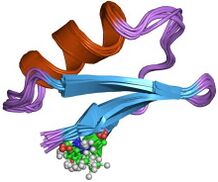Chemistry:Charybdotoxin
| Charybdotoxin | |||||||
|---|---|---|---|---|---|---|---|
 | |||||||
| Identifiers | |||||||
| Organism | |||||||
| Symbol | ChTX | ||||||
| Alt. symbols | ChTX-Lq1, ChTx-a | ||||||
| CAS number | 95751-30-7 | ||||||
| PDB | 2crd (ECOD) More structures | ||||||
| UniProt | P13487 | ||||||
| |||||||
Charybdotoxin (ChTX) is a 37 amino acid neurotoxin from the venom of the scorpion Leiurus quinquestriatus hebraeus (deathstalker) that blocks calcium-activated potassium channels.[2] This blockade causes hyperexcitability of the nervous system. It is a close homologue of agitoxin and both toxins come from Leiurus quinquestriatus hebraeus. It is named after Charybdis, a sea monster from Greek myth.[3]
Chemical properties
Family
The Charybdotoxin family of scorpion toxins is a group of small peptides that has many family members, such as the pandinotoxin, derived from the venom of scorpion Pandinus imperator.[4]
Structure
Scorpions such as the deathstalker paralyze their prey by injecting a potent mix of peptide toxins.[5] Charybdotoxin, a 37 amino acid, 4 kDa neurotoxin with the molecular formula C176H277N57O55S7, is one of the peptide toxins that can be extracted from the venom of the scorpion. Its structure is very similar to that of margatoxin. Charybdotoxin contains three disulfide bridges.[6]
Mode of action
Charybdotoxin occludes the pore of calcium-activated voltage-gated shaker K+ channels by binding to one of four independent, overlapping binding sites.[7][8] It binds both to the open and the closed states. In addition, the block is enhanced as the ionic strength is lowered.[9] This block occurs as the Asn 30 on the CTX interacts with the Asp 381 on the K+ channel.[10] The blockade of K+ channels by the charybdotoxin peptide causes neuronal hyperexcitability. Mutations of the Lys31Gln and the Asn30Gln had the effect of lessening the CTX block of the pore on the shaker channel.[10]
Treatment
Anti-scorpion venom serum (AScVS) is an effective and safe method of therapy in severe scorpion envenoming syndrome. Compared with other therapies like alpha blockers it has a relatively short recovery period (10 vs 16–42 hours).[11]
References
- ↑ "Electrostatic binding of proteins to membranes. Theoretical predictions and experimental results with charybdotoxin and phospholipid vesicles". Biophys. J. 73 (4): 1717–27. October 1997. doi:10.1016/S0006-3495(97)78203-1. PMID 9336168. Bibcode: 1997BpJ....73.1717B.
- ↑ "Evaluation of the relaxant effects of SCA40, a novel charybdotoxin-sensitive potassium channel opener, in guinea-pig isolated trachealis". Br. J. Pharmacol. 108 (3): 622–6. March 1993. doi:10.1111/j.1476-5381.1993.tb12851.x. PMID 7682131.
- ↑ Senning, Alexander (2006-10-30). Elsevier's Dictionary of Chemoetymology: The Whys and Whences of Chemical Nomenclature and Terminology. Elsevier. ISBN 978-0-08-048881-3. https://books.google.com/books?id=Fl4sdCYrq3cC&pg=PA99.
- ↑ "Solution Structure for Pandinus Toxin K-R (PiTX-KR), a Selective Blocker of A-Type Potassium Channels". Biochemistry 36 (10): 2763–71. 1997. doi:10.1021/bI9628432. PMID 9062103.
- ↑ Purves D, Augustine GJ, Fitzpatrick D, Hall WC, Lamantia AS, McNamara JO, Williams SM. Neuroscience, p82.
- ↑ "Mechanisms of maurotoxin action on Shaker potassium channels". Biophys. J. 79 (2): 776–87. August 2000. doi:10.1016/S0006-3495(00)76335-1. PMID 10920011. Bibcode: 2000BpJ....79..776A.
- ↑ "Electrostatic interaction between charybdotoxin and a tetrameric mutant of Shaker K(+) channels". Biophys. J. 78 (5): 2382–91. May 2000. doi:10.1016/S0006-3495(00)76782-8. PMID 10777734. Bibcode: 2000BpJ....78.2382T.
- ↑ "A strongly interacting pair of residues on the contact surface of charybdotoxin and a Shaker K+ channel". Neuron 16 (1): 123–30. January 1996. doi:10.1016/S0896-6273(00)80029-X. PMID 8562075.
- ↑ "Charybdotoxin block of Shaker K+ channels suggests that different types of K+ channels share common structural features". Neuron 1 (10): 997–1001. December 1988. doi:10.1016/0896-6273(88)90156-0. PMID 2483094.
- ↑ 10.0 10.1 "Interaction of agitoxin2, charybdotoxin, and iberiotoxin with potassium channels: selectivity between voltage-gated and Maxi-K channels". Proteins 52 (2): 146–54. August 2003. doi:10.1002/prot.10341. PMID 12833539.
- ↑ "Efficacy of species specific anti-scorpion venom serum (AScVS) against severe, serious scorpion stings (Mesobuthus tamulus concanesis Pocock)—an experience from rural hospital in western Maharashtra". J Assoc Physicians India 54: 283–7. April 2006. PMID 16944610.
 |
